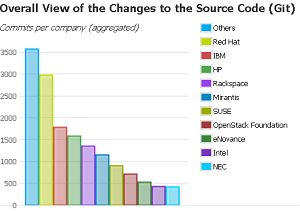Red Hat Touts VMware Integration in OpenStack Release
Enterprise Linux giant Red Hat is pushing further into the OpenStack arena with the release of Red Hat Enterprise Linux OpenStack Platform 5.
The company touts integration with VMware infrastructure as a key selling point of its distribution of the OpenStack cloud OS/platform. That's just one of "hundreds" of reported improvements to the OpenStack core components: compute, storage and networking. Other enhancements include three-year support and new features such as configuration and installation enhancements designed to help enterprises adopt OpenStack technology.
OpenStack is an open source project originally created by Rackspace Hosting and NASA, now under the direction of a consortium of industry heavyweights, including Red Hat. In fact, Red Hat -- which says it's "all in on OpenStack" -- has been the No. 1 contributor to recent OpenStack distributions, the last being Icehouse, released in April. As with Linux, the vendor makes money by bundling its distribution with services, support and extra features realized as part of the company's development model of "participate, stabilize, deliver."
 [Click on image for larger view.]
Red Hat leads individual contributors to the open source OpenStack project.
[Click on image for larger view.]
Red Hat leads individual contributors to the open source OpenStack project.
(source: OpenStack.org)
The distribution -- which went into beta in May -- is based on Red Hat Enterprise Linux 7, just released a couple months ago. Its improved support of VMware infrastructure touches on virtualization, management, networking and storage functionalities.
"Customers may use existing VMware vSphere resources as virtualization drivers for OpenStack Compute (Nova) nodes, managed in a seamless manner from the OpenStack Dashboard (Horizon)," Red Hat said in an announcement. The new product also "supports the VMware NSX plugin for OpenStack Networking (Neutron) and the VMware Virtual Machine Disk (VMDK) plugin for OpenStack Block Storage (Cinder)."
Red Hat's OpenStack offering -- aimed at advanced cloud users such as telecommunications companies, Internet service providers and cloud hosting providers -- comes with a three-year support lifecycle, backed by a partner ecosystem with more than 250 members.
New features include better workload placement via server groups. Companies can choose to emphasize the resiliency of distributed apps by spreading them across cloud resources, or ensure lower communications latency and improved performance by locating them closer.
Red Hat also said the interoperability of heterogeneous networking stacks is enhanced through the new Neutron modular plugin architecture. That lets enterprises more easily add new components to their OpenStack deployments and provide better mix-and-match networking solutions.
A more technical enhancement is the use of the "para-virtualized random number generator device" that came with Red Hat Enterprise Linux 7, so guest applications can use better encryption and meet new cryptographic security requirements.
Red Hat said that in the coming weeks it will make generally available an OpenStack distribution based on its previous Linux distribution, version 6. The company will maintain dual versions so customers can best complement the OS they're using.
According to an IDG Connect survey commissioned last year by Red Hat, that overall customer base is expected to grow. The survey said 84 percent of respondents indicated they had plans to adopt OpenStack technology.
Posted by David Ramel on 07/09/2014 at 1:49 PM